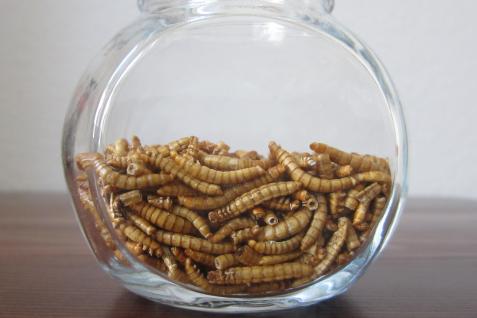‘Future foods’ like mealworm beetles can be the key to sustainable agriculture. WILHELM THOMAS FIEGE / WIKIMEDIA COMMONS
Food insecurity and malnutrition remain persistent problems affecting the world’s most vulnerable populations. Organizations like the United Nations have made some progress in addressing these issues, which currently affect around 690 million people. However, a recent study by the University of Cambridge suggests that newer, more radical methods are needed.
Dr. Study written by Asaf Tzachor, Catherine Richards and Lauren Holt (part of the Interdisciplinary Center for the Study of Existential Risks at the University of Cambridge) has been published in Nature Food. It advocates the use of “future foods,” alternative food sources made using non-traditional farming techniques. These have the potential to revolutionize food production.
The diet is currently based on plant foods (PSF) – mainly wheat, corn and soybeans – and animal foods (ASF) such as meat, dairy products and eggs. Both types of food are susceptible to external disturbances, including pathogens such as salmonella and Escherichia coli (E. coli), as well as environmental changes.
“Microalgae, macroalgae, and insect larvae can be incorporated into foods like energy bars, pasta, and burgers.”
In comparison, future foods are more sustainable and yet very nutritious. It is hoped that they can be used to develop risk-resistant diets that are more resilient to local and global disturbances, thereby providing the macronutrients and micronutrients necessary for human health on a more consistent basis.
The report advocates increasing the global production and consumption of future foods such as microalgae like Spirulina and Chlorella, which have rapid growth rates that can be further increased by the use of light emitting diodes. It also promotes macroalgae such as sugar kelp and mussels, which can now be grown on an industrial scale in coastal and offshore environments (overcoming the spatial constraints created by their usual growing locations). It is also hoped that insect larvae – such as those of the black soldier fly, housefly and mealworm beetle – can be successfully produced on a large scale.
In anticipation of public reluctance to eat these foods, the researchers suggest that they could be used as ingredients in popular foods instead of being eaten whole. Microalgae, macroalgae, and insect larvae can be incorporated into foods like energy bars, pasta, and burgers. The report also highlights mycoprotein, an established popular source of protein from mushrooms that has been successfully used in numerous alternative meat products such as Quorn®.
Polycentric Food Networks
Future foods will be developed in closed systems with carefully controlled physical, chemical and biological conditions. This reduces the risks associated with traditional PSF and ASF farming, creating a more stable food supply. Their resilience is further increased through the use of modular environments, which consist of several stacked kindergarten or bioreactor chambers, creating a system that can be scaled as needed.
“To future-proof our food supply, we need to integrate completely new types of agriculture into the current system.”
The lack of flexibility in traditional food production techniques was underscored by the Covid-19 pandemic, which disrupted the globalized supply chains on which traditional food production depends. The need for a modular production system that can quickly adapt to unexpected spatial and temporal disruptions, especially within the supply chain, became apparent.
These units are then used to build decentralized “polycentric food networks,” which are geographically very different production systems that can be in multiple geographic locations, reducing the risk of local disruption or dependency on specific regions.
Polycentric food networks also enable isolated communities – such as the Pacific island states – to produce their own food sources. The Pacific island nations have been unable to deploy traditional PSF and ASF on a large scale and instead have been forced to rely on unstable and sometimes volatile global supply chains.
An unstable environment
Recent anthropogenic climate change has further increased the fragility of agricultural ecosystems due to the increasing frequency and intensity of hazards such as droughts, floods, forest fires and frost. The disruptive effects of climate change are likely to be most severe in developing countries, which already have very high rates of malnutrition and food insecurity.
Traditional food systems are therefore currently facing the double pressures of Covid-19 and anthropogenic climate change, with limited ability to adapt to the rapidly changing pressures they create. As a result, Dr. Asaf Tzachor suggested that “in order to future-proof our food supply, we have to integrate completely new types of agriculture into the current system”.
Reliance on traditional systems of agricultural production should be minimized. Instead, new forms of production should be introduced to produce foods that are more stable, nutritious and sustainable. The use of future foods will hopefully ensure that this is accessible to all.
Varsity is the University of Cambridge’s independent newspaper, founded in its current form in 1947. In order to maintain editorial independence, our print and news website does not receive funding from the University of Cambridge or its constituent colleges.
We therefore rely almost entirely on advertising for funding, and we await difficult months and years during this unprecedented global crisis.
Despite this situation, we will look for inventive ways to provide our readership with digital content and, of course, in print.
That is why we ask our readers, if they wish, to donate as little as £ 1 to cover our running costs at least until this global crisis ends and things get back to normal.
Thank you, we all here at Varsity want to wish you, your friends, families, and all your loved ones a safe and healthy few months in advance.










